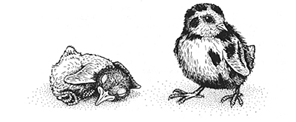|
"Precocial" and "altricial," two words describing the degree of development in young birds at hatching, are good examples of useful scientific jargon. They save ornithologists from repeatedly using phrases when single words will do. A precocial bird is "capable of moving around on its own soon after hatching." The word comes from the same Latin root as "precocious." Altricial means "incapable of moving around on its own soon after hatchling." It comes from a Latin root meaning "to nourish" a reference to the need for extensive parental care required before fledging in altricial species. If you consult some of the literature we have cited, you may sometimes see the term "nidifugous" used to describe precocial young that leave the nest immediately, and "nidicolous" to describe young that remain in the nest. All nidifugous birds are precocial, but some nidicolous birds are precocial, too-they remain in the nest even though capable of locomotion. These terms are less widely used than precocial and altricial, and we will not employ them outside of this essay. Instead of a sharp dividing line between hatchlings that are precocial and those that are altricial, there is a gradient of precociality. In this guide, we recognize the following categories of young: Precocial Hatched with eyes open, covered with down, and leave the nest within two days. There are four levels of precociality, although only three are found in North American birds. Level 1 of development (precocial 1) is the pattern found in the chicks of megapodes (Australian Malee fowl, Brush Turkeys, etc.), which are totally independent of their parents. The megapode young are incubated in huge piles of decaying vegetation, and upon hatching dig their way out, already well feathered and able to fly. No North American birds show this extreme precociality. Precocial 2 development is found in ducklings and the chicks of shorebirds, which follow their parents but find their own food. The young of game birds, however, trail after their parents and are shown food; they are classified as precocial 3. Precocial 4 development is represented by the young of birds such as rails and grebes, which follow their parents and are not just shown food but are actually fed by them. Note that in the species treatments in this book we use the term "fledging" (F:) for the number of days it takes for the young of an altricial or semi-altricial bird to acquire its full set of feathers, after which it leaves the nest. Thus for altricial and semi-altricial birds, the time needed to get fully feathered and time spent in the nest are essentially the same. In precocial and semi-precocial birds, F: indicates not the number of days that pass before the young leave the nest, but the time from hatching until they can fly.
Left: House Sparrow
hatchling (altricial-naked, blind and helpless on
hatching).
TYPE
OF DOWN EYES MOBILE?. Interestingly, there seems to be an evolutionary trade-off in bird brain sizes related to the degree of precocity. Precocial species have relatively large brains at hatching-as one might expect since the young, to one degree or another, must be able to fend for themselves. But precocial species trade for this advantage an adult brain that is small in relation to their body size. Altricial young, in contrast, are born small-brained, but on the pro-tern-rich diet provided by the adults (and with their highly efficient digestive tracts) postnatal brain growth is great, and the adults have proportionally larger brains than precocial species. Parrots have evolved their way into the best of both worlds. They are altricial, but the female invests in a nutrient-rich egg just like females of precocial species. Parrots are among the most intelligent of birds; they have adopted the same evolutionary strategy as we have. People (like other primates, elephants, and antelopes, but unlike rodents and marsupials) are precocial-born with hair, open eyes, and large brains. But our brains and those of parrots, both large at birth, also grow a great deal after birth as a result of large parental investments of food energy. Thus a complex evolutionary problem of balancing the need to provide nourishment to the young and to protect them from predation has been "solved" by each group of birds-and the solutions are the different avian developmental patterns we now observe. Similar problems have been solved, also in diverse ways, in the course of mammalian evolution. But many more groups of mammals than birds have managed to become big-brained as both young and adults. SEE: Parental Care. Copyright ® 1988 by Paul R. Ehrlich, David S. Dobkin, and Darryl Wheye. |
